- 1Hauner Children's Hospital, Ludwig Maximilians University, German Center for Lung Research (DZL), Munich, Germany
- 2European Reference Network for Rare Diseases of the Respiratory System (ERN-LUNG), Munich, Germany
- 3Health Technology Assessment Area-AETSA, Andalusian Public Foundation for Progress and Health (“Fundación Progreso y Salud”–“FPS”), Seville, Spain
- 4Movement Disorders Unit, Department of Child Neurology, Institut de Recerca Sant Joan de Déu, Barcelona, Spain
- 5Research Group HUM604: Lifestyle Development in the Life Cycle and Health Promotion, University of Huelva, Huelva, Spain
- 6Frankfurter Referenzzentrum für Seltene Erkrankungen (FRZSE), Universitätsklinikum Frankfurt am Main, Wolfgang von Goethe-Universität, Munich, Germany
- 7U-703 Centre for Biomedical Research on Rare Diseases (CIBER-ER), Instituto de Salud Carlos III, Barcelona, Spain
- 8European Reference Network for Rare Neurological Diseases (ERN-RND), Tübingen, Germany
Background: NKX2-1-related disorders (NKX2-1-RD) encompass a spectrum of conditions arising from pathogenic deletions or variants in the NKX2-1 gene, crucial for thyroid, lung, and brain development. Respiratory manifestations in NKX2-1-RD range from neonatal respiratory distress to severe lung diseases, constituting a leading cause of mortality. This study will review and synthesize NKX2-1-RD respiratory phenotypes, genetic alterations, and long-term trajectories.
Methods: We conducted a systematic review using PRISMA and PICO question formats. From January 2002 to July 2023, major biomedical databases and rare disease resources were searched. Genetically confirmed NKX2-1-RD patients with respiratory symptoms were eligible for this study.
Results: Out of 4,569 studies, 38 met inclusion criteria, predominantly case reports and series. The study included 148 patients, revealing diverse respiratory phenotypes and treatments. Respiratory manifestations emerged at various ages, with neonatal respiratory distress, asthma, interstitial lung disease, and lung cancer observed. Nonsense mutations in NKX2-1 were linked to lung cancer. Treatment varied, including oxygen supplementation, ventilation, antibiotics, and lung transplantation. Long-term follow-up disclosed heterogeneous respiratory outcomes, with some patients asymptomatic while others faced chronic insufficiency or recurrent infections. The overall survival of informed cases was about 60%.
Conclusion: This study highlights the complex respiratory manifestations of NKX2-1-RD and their impact on patient outcomes. The findings support standardized respiratory follow-up protocols and provide clinical management insights despite study quality and sample size limitations. We discuss the challenges of treating diverse respiratory conditions in this rare clinical entity and lay the groundwork for future research.
Introduction
NKX2-1-related disorders (NKX2-1-RD, OMIM#610978) refer to a group of disorders associated with pathogenic deletions or variants in the NKX2-1 gene. Formerly identified as thyroid transcription factor 1 (TTF-1), the NKX2-1 gene plays a pivotal role in organ development, impacting the thyroid, lung, and brain. Specifically, NKX2-1 orchestrates pulmonary development by influencing lung patterns, including proximal airway structures (1), and modulating genes involved in epithelial cell fate determination (2–4). This regulatory function extends to the activation of lung-specific genes such as SP-A (5), SP-B (6), and SP-C (7), encoding crucial pulmonary surfactant proteins. Additionally, NKX2-1 involvement in lung cancer pathogenesis (8) underscores its significance as a biomarker for distinguishing primary lung adenocarcinomas from other pulmonary conditions (9, 10).
Respiratory manifestations linked to NKX2-1-RD encompass a broad spectrum, including interstitial lung disease (ILD), neonatal respiratory distress syndrome (RDS), recurrent infections, chronic respiratory insufficiency, pulmonary hypertension, asthma, and lung cancer. Understanding this range of respiratory manifestations is pivotal for recognizing diverse clinical presentations, facilitating accurate diagnoses, and customizing effective management strategies. Furthermore, this comprehension significantly contributes to ongoing scientific endeavors and the development of therapeutic interventions. Of particular note is the observation that respiratory mortality in NKX2-1-RD is primarily attributed to neonatal respiratory distress syndrome, interstitial lung disease, and pulmonary fibrosis (11).
Recognizing the gravity of these respiratory implications, the European Reference Network for Rare Neurological Disorders (ERN-RND), in collaboration with ERN-Lung, is actively engaged in establishing inaugural clinical practice guidelines for NKX2-1-RD. This initiative, part of the broader European Program ERN Guidelines, aspires to provide an up-to-date synthesis of available evidence on respiratory manifestations associated with NKX2-1-RD.
Methods
This study comprises systematic reviews of two research questions reported following the Preferred Reporting Items for Systematic Review and Meta-Analyses (PRISMA) statement (12).
Research question
The PICO (Population-Intervention-Comparator-Outcome) question format was employed to guide the literature search, posing the following inquiries: What are the best procedures for the diagnosis of lung diseases in patients with NKX2-1-related disorders? and What are the best procedures for treatment and follow-up of lung diseases in patients with NKX2-1-related disorders? (Supplementary Data 1). These questions covered all the aspects related to the detection, diagnosis, treatment, and follow-up of respiratory manifestations in NKX2-1-RD. The protocols of the systematic reviews for each question were previously registered in the International Prospective Register of Systematic Reviews (PROSPERO) repository with the identifications CRD42023448437 and CRD42023448440.
Eligibility criteria
Specific inclusion criteria were employed to select the relevant studies for these systematic reviews. The population criteria were common for both research questions: patients of all ages with genetic confirmation of the disease (variants in NKX2-1, previously known as TTF-1, or deletion in the 14q13.3 chromosome) with respiratory manifestations. Non-human studies and patients without genetic confirmation of the disease were excluded. Given the rare condition, any comparator was used.
The following specifications apply to the interventions and their outcomes: For diagnosis, the interventions included physical examination, pulse oximetry test, blood tests (blood gases, hemogram, reactive C protein, blood culture, etc.), pulmonary function testing (spirometry, bodyplethysmography), exercise tolerance testing, diffusion capacity for carbon monoxide (DLCO), imaging (chest X-ray, CT scan, PET-CT scan), lung biopsy (transbronchial forceps- or cryobiopsy, open- or thoracoscopic biopsy), and outcomes were determined based on test results related to the diagnosis. Regarding treatment, the interventions comprised supplementary oxygen, noninvasive and invasive respiratory support, medication (bronchodilators, corticosteroids, immunosuppressive therapy, antibiotics, exogenous surfactant, etc.), chest physiotherapy, lung transplant, cancer surgery, radiotherapy, chemotherapy, and supportive care, including nutrition, immunization, and environmental care. Outcomes were assessed in terms of the indication for hospitalization, treatment effectiveness, adverse effects of treatments, treatment in special situations (pregnancy), and follow-up (lung outcomes, patient and professional education, quality of life, and self-management in adulthood).
The included study designs were primary studies, systematic reviews, and randomized controlled trials (RCTs). Narrative reviews, protocols, conference articles, editorials, letters to the editor, and those whose full text was unavailable to be retrieved were excluded. While the inclusion criteria allowed articles in all languages, all retrieved articles were written in English.
Search strategy
A systematic literature search was carried out for each research question to review the scientific evidence. MEDLINE (Ovid), Embase (Elsevier), the Cochrane Library (Wiley), APA PsycInfo (EBSCO), CINAHL Complete (EBSCO), the Web of Science (WOS), the TRIP PRO medical database, and the International Health Technology Assessment (INAHTA) database were searched as reference databases, and additional databases were included to retrieve gray literature such as the Cochrane Controlled Register of Trials (CENTRAL) and subject-specific information resources on rare diseases, Orphanet, EURORDIS, NORD, RARE-Best Practices, and Gene Reviews.
The searches covered the period from January 2002 to August 2022, and were updated in July 2023. The included records date back to 2002, when the NKX2-1 gene variants were first discovered and named. Both controlled language (descriptors) and free terminology were used to search for studies. The initial strategies were carried out in MEDLINE (Ovid) and later adapted to each database’s syntax. The Medline searches for each systematic review are available in Supplementary Data 8.
Study screening and data extraction
The identified references were imported into the reference management section of the Covidence Systematic Review Software (Veritas Health Innovation; 2023, https://www.covidence.org/), and the duplicates were automatically removed. A different review was created for each question. Two authors independently filtered the references by title, abstract, and full text (KM, ARR) according to the selection criteria. The disagreements between the reviewers were resolved by a third researcher (JDOE). The data were extracted by two independent authors (KM, ARR) and recorded in Excel spreadsheets. Detailed information from the studies, including authorship, publication year, study design, and location, was systematically extracted. Furthermore, specific clinical data for each patient, encompassing age, gender, results of genetic tests, pulmonary diagnosis, diagnostic procedures, phenotype, treatment modalities, follow-up information, and other relevant data, were meticulously documented.
Quality assessment
The methodological quality assessment of each study was conducted independently by two authors (KM, ARR), and discrepancies in individual assessments were resolved through discussion to achieve consensus. Specific tools tailored to each study type were employed for quality assessment. The identified references were categorized as case reports, case series, and cohort studies. Case reports and case series were assessed using the tool developed by Murad et al. (13) that evaluates methodological quality in low-evidence studies crucial for decision-making. The tool consists of eight items across four domains (selection, ascertainment, causality, and reporting). Article quality was rated based on the sum of binary responses (1 = low risk of bias, 0 = high risk of bias) for each item, resulting in a score ranging from 0 (poor quality) to 8 (high quality) (14). Adaptations to the ascertainment, causality, and reporting items were made to suit the specific clinical scenario addressed in the research questions.
Results
Study selection
During the initial search, a total of 4,576 records were located. After removing duplicates, 4,560 potentially relevant studies remained. Title and abstract screening were carried out, yielding 131 studies. Nine references were added after specialist consultants (15–24). While conducting additional NKX2-1 reviews addressing different questions than those posed by the respiratory PICO, the authors observed that the systematic search did not retrieve these nine studies. These studies were included later due to their focus on respiratory symptoms of the disease, which, although important, were not the primary target of the initial search strategy. These studies primarily addressed other affected systems, and it is likely that they were not indexed under the search terms we used, which is why they were not retrieved in the initial search. After further evaluation, it was determined that these studies included patients with respiratory symptoms, justifying their inclusion.
According to inclusion and exclusion criteria, 51 studies were included following full-text screening. 13 included studies were shared by the two PICO questions. Therefore, 38 studies were finally analyzed (15–23, 25–53). Additionally, three references (24, 54, 55) were initially included in the PICO questions. However, during data extraction, the reviewers identified that these studies referred to patients already included in other studies. The two independent screening processes (PRISMA flowcharts) are depicted in Figures 1A,B. The list of included and excluded articles after full-text review, along with the reasons for their exclusion, is shown in Supplementary Data 2. The excluded studies were classified according to the first criterion that did not fit the PICO format.
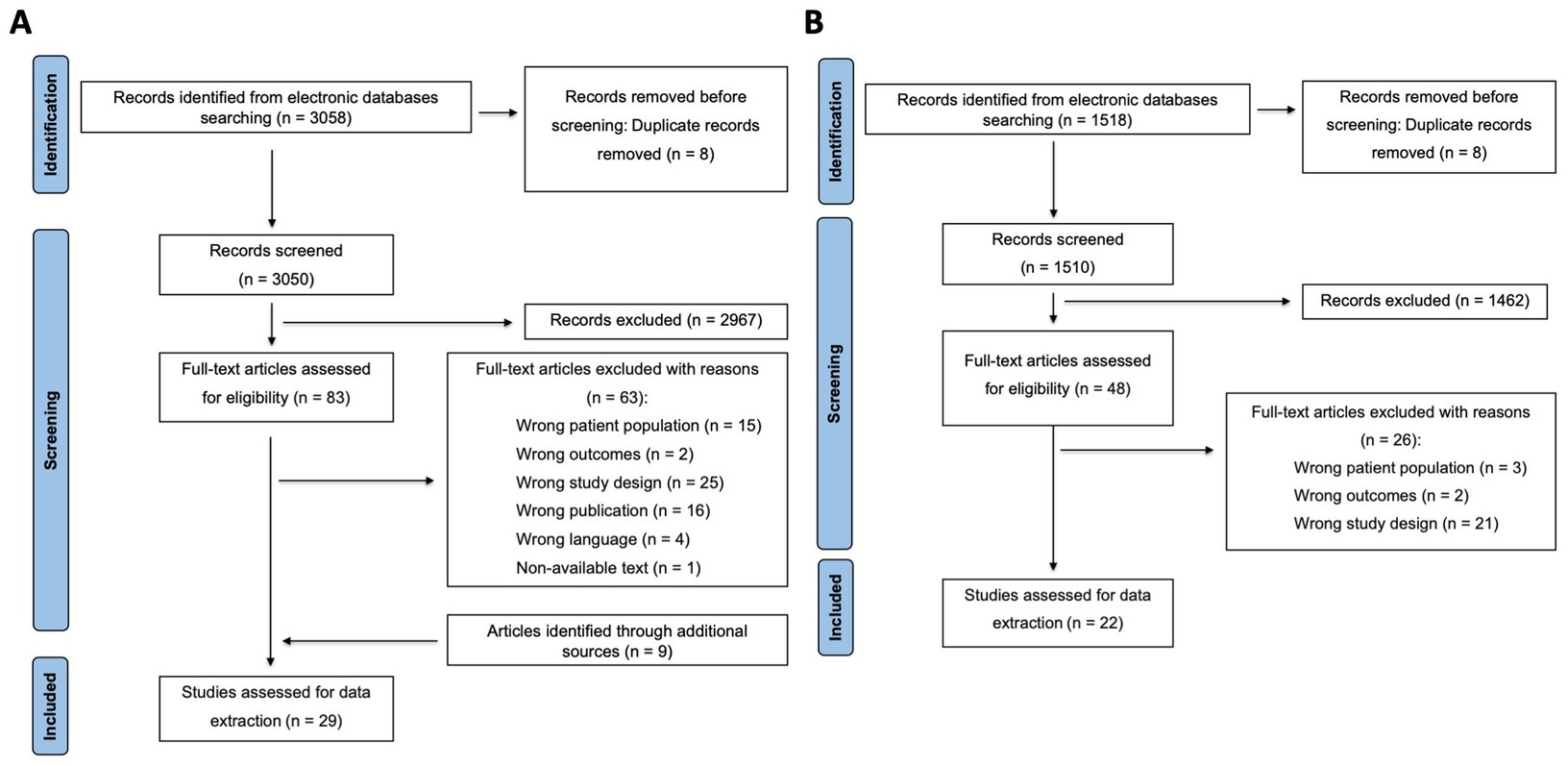
Figure 1. Illustrates the PRISMA flowchart depicting the title-abstract and full-text screening of the articles related to the respiratory manifestations in patients with NKX2-1-RD. (A) What are the best procedures for the diagnosis of lung diseases in patients with NKX2-1-related disorders? (B) What are the best procedures for treatment and follow-up of lung diseases in patients with NKX2-1-related disorders?
Study characteristics
44.7% of the included studies were case series (n = 17), and 55.3% were case reports (n = 21). No cohort studies were identified. Due to the rare clinical condition studied, no anticipated randomized controlled trials or systematic reviews were available. 44.7% of the data originated from Europe (n = 17), 44.7% from America (n = 17), 7.9% from Asia (n = 3), and 2.6% from Australia (n = 1) (Supplementary Data 3).
Patients’ demographics and respiratory manifestations
The data were collected from 148 patients, comprising 56 males and 67 females, and 25 individuals with unknown sex (Figure 2A; Supplementary Data 4). Among the 92 cases with available gestational age data, 82 were classified as term and 10 as preterm (Figure 2B). Newborn screening for hypothyroidism was available in 115 out of 148 patients, with 20 testing positive and 95 negative. Respiratory symptoms typically manifest at a mean age of 4.4 years, with a median of 30 days (neonatal period), spanning from birth to 73 years.

Figure 2. Distribution of (A) sex and (B) gestational age classification among the studied patients.
The initial respiratory symptoms were diverse, including neonatal respiratory distress syndrome (RDS) in 70 patients, asthma and/or wheezing in 20 patients, ILD (with or without hypoxemia), including pulmonary fibrosis in nine patients, severe or recurrent infection with chronic cough in 7 patients, tachypnea and/or hypoxemia in 13 patients, and lung cancer in 1 patient.
In relation to the NKX2-1-RD phenotype, diverse clinical presentations were observed within the studied cohort, both at diagnosis and throughout the disease course. All 148 patients had pulmonary involvement; this was exclusive in only 15 patients, while five showed pulmonary and endocrinological manifestations. Additionally, 19 patients displayed a combination of pulmonary and neurological involvement. The most prevalent category encompassed patients with pulmonary, endocrinological, and neurological manifestations, totaling 86 individuals with this set of phenotypes. 23 subjects had incomplete information that prevented a precise determination of their phenotype, and 4 additional patients were excluded due to issues with the available data. These patients were not included in the detailed analysis. Similarly, in the following, we use only the informative cases available as the denominator.
Phenotypic respiratory diversity and other organ involvement in NKX2-1-RD
NKX2-1-RD demonstrates phenotypic respiratory diversity along with endocrinological and neurological involvement. Among the patients, neonatal RDS not progressing to ILD was observed in 52 out of 143 cases (male/female 17:25, unknown 10), while neonatal RDS progressing to ILD was noted in 30 out of 140 patients (male/female 19:9, unknown 2). The difference in sex distribution between these groups was statistically significant (χ2 = 4.01, p = 0.045; Fisher’s exact test p = 0.030), suggesting a potential association between male sex and the progression to ILD. Recurrent infections were reported in 59 out of 99 cases (male/female 15:23, unknown 21), and ILD without neonatal RDS was present in 27 out of 142 patients (male/female 8:19). Chronic respiratory insufficiency occurred in 38 out of 123 cases (male/female 19:19), pulmonary hypertension in 15 out of 135 patients (male/female 7:8), and asthma, recurrent bronchial obstruction, or wheeze in 27 out of 133 cases (male/female 12:11, unknown 4). Additionally, lung cancer was observed in three out of 115 patients (male/female, 1:2) (Figure 3). The alluvial diagram and the multi-step alluvial diagram in Figures 4A, B illustrate the interplay of distinct phenotypes in patients exhibiting respiratory manifestations and variants or deletions in NKX2-1.
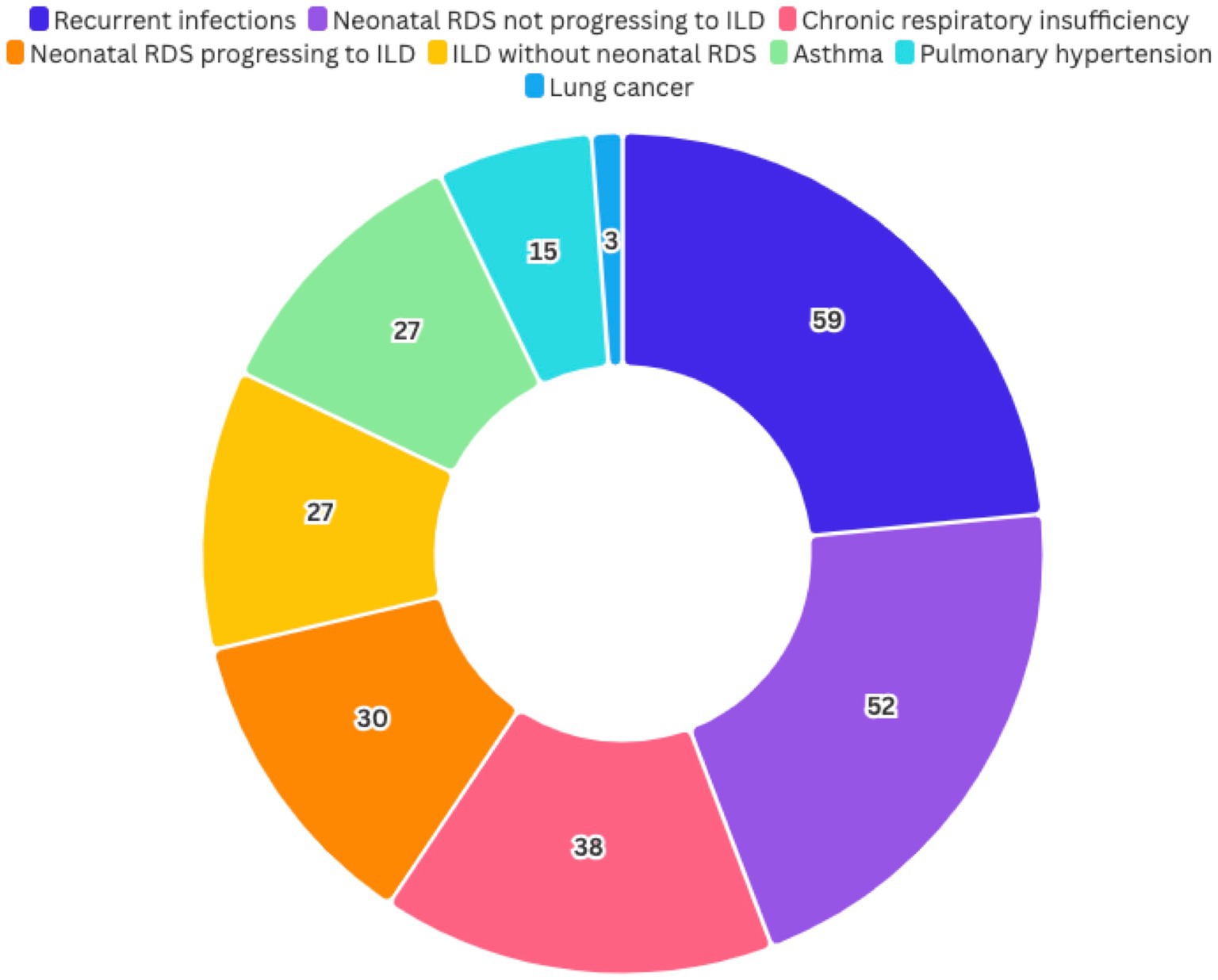
Figure 3. Distribution of patients across various respiratory phenotypes, highlighting the presence of conditions such as neonatal respiratory distress syndrome (RDS), interstitial lung disease (ILD), recurrent infections, chronic respiratory insufficiency, pulmonary hypertension, asthma, and lung cancer.
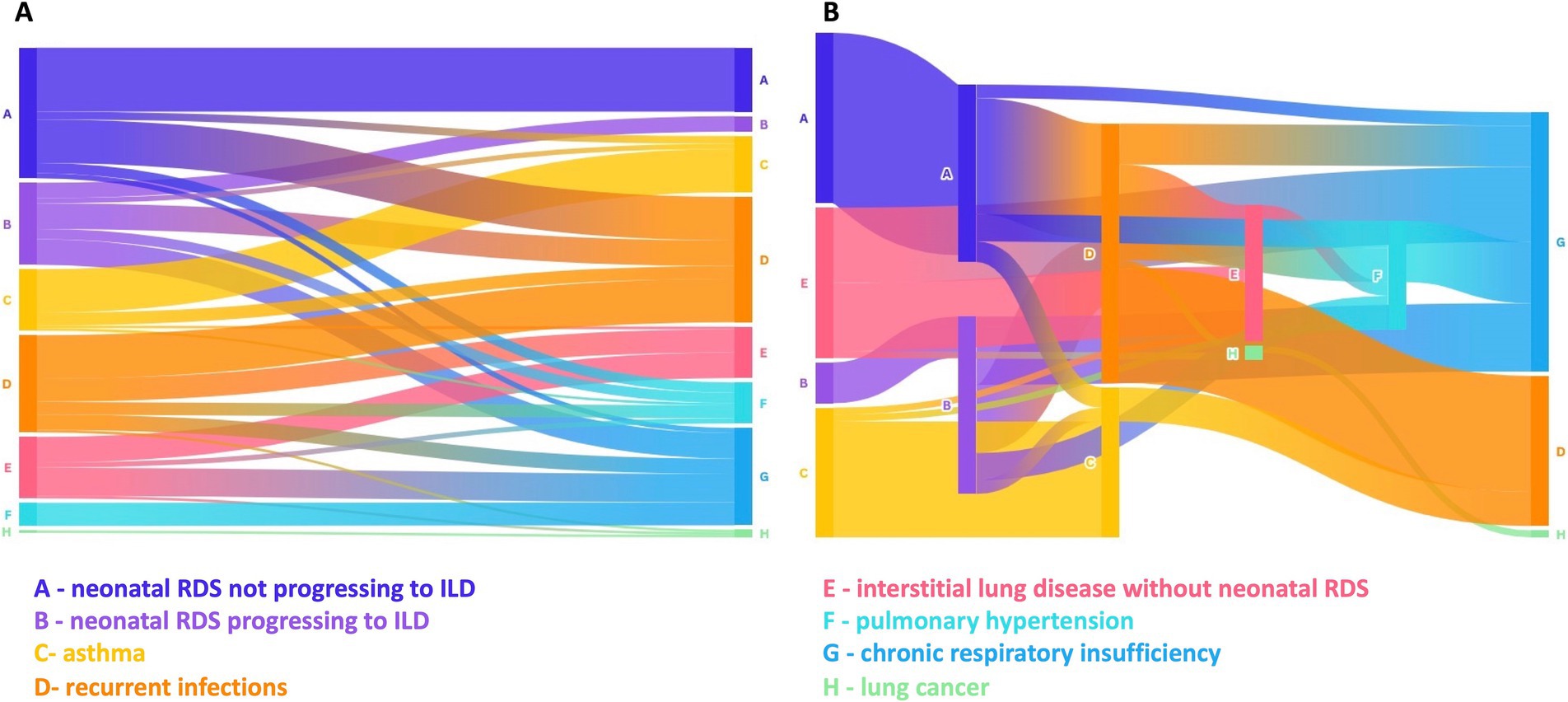
Figure 4. (A) An alluvial diagram illustrating the transition of patients from one respiratory phenotype to another over time. (B) Multi-step alluvial diagram depicting cases with complex trajectories, where patients exhibited multiple respiratory phenotypes throughout their clinical course.
Endocrinological involvement was present in 90 out of 131 cases, and neurological involvement was reported in a substantial 104 out of 124 cases.
Among the 15 cases with possibly exclusive respiratory manifestations, the distribution of respiratory phenotypes is presented in Table 1.
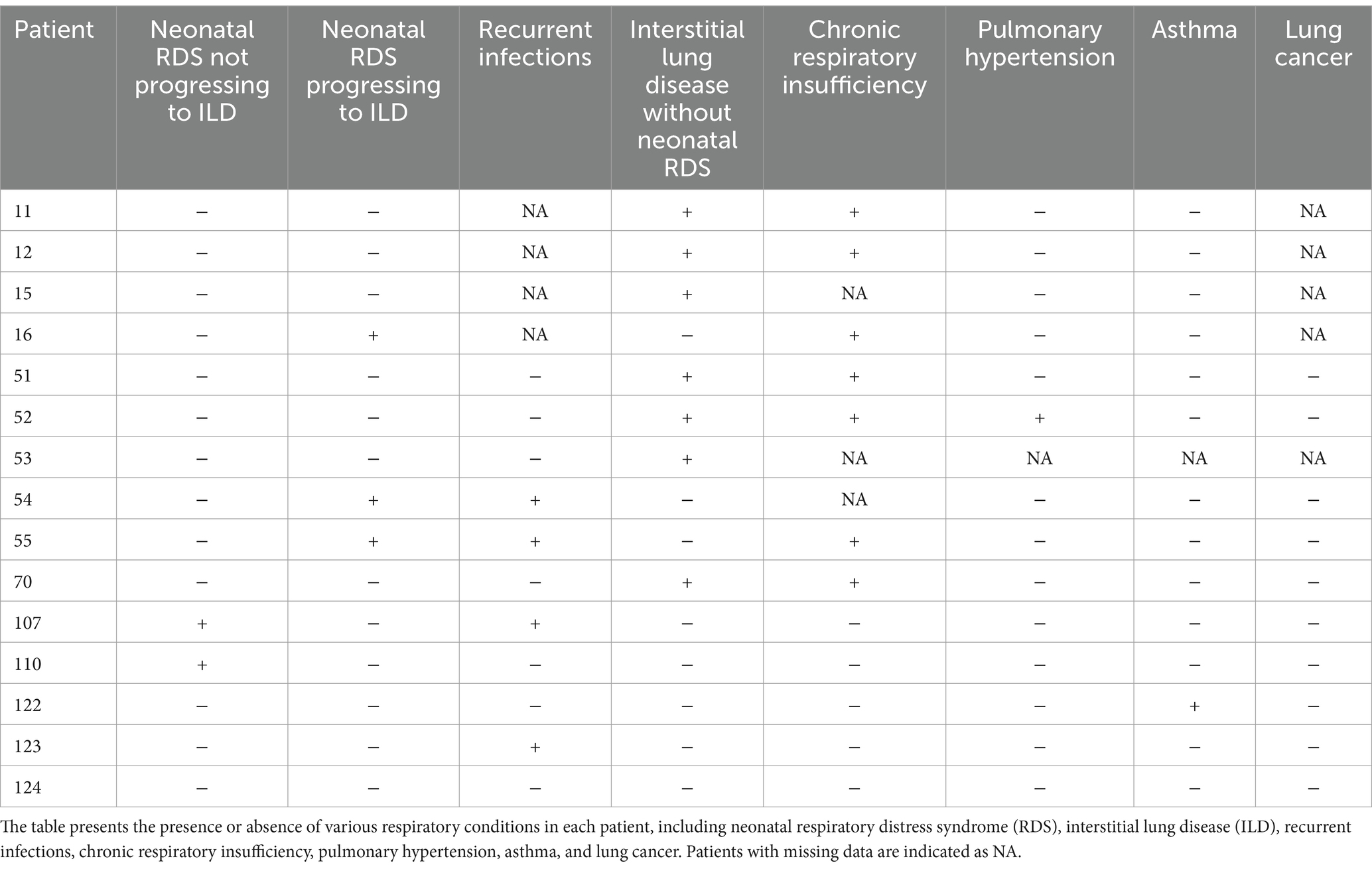
Table 1. Distribution of respiratory phenotypes in patients with exclusively respiratory symptoms (without thyroid or neurological involvement).
Respiratory features observed across imaging, BAL, and biopsy assessments
For a very small fraction of patients, detailed respiratory information (including imaging) was available. Chest radiography (CR) was available for 10 out of 148 patients, with six showing diffuse bilateral opacities and three displaying bilateral opacities alongside other abnormalities such as infiltrates, pneumothorax, or atelectasis, and one case presented with parahilar infiltrates.
CT scans were reported for 34 out of 148 patients; focal consolidations were identified in 12 cases; and ground glass opacities were evident in 24 cases. Additionally, septal or pleural thickening, cystic lesions, bronchiectasis, and architectural distortion were each observed in four cases. Features consistent with usual interstitial pneumonia and a fibrosing interstitial pattern were present in three cases each. Furthermore, two cases exhibited nodular opacities, hilar adenopathy, and paraseptal emphysema.
Regarding pulmonary function test results, nine patients had detailed outcomes (Supplementary Data 5). All patients were older than 6 years (mean 32.2 years, median 25 years, range 8–61 years). Among the patients with results, the pulmonary phenotype included interstitial lung disease without neonatal RDS in 8 patients, recurrent infections in 4 patients, chronic respiratory insufficiency in 3 patients, neonatal RDS progressing to ILD in 1 patient, and lung cancer in 1 patient.
In addition to the pulmonary function tests, bronchoalveolar lavage (BAL) analyses were reported in 11 out of 148 patients; findings revealed neutrophilic inflammation in five cases, decreased levels of surfactant proteins B (SP-B) and C (SP-C) in two cases, and lymphocytic inflammation in one case.
16 histopathological descriptions of lung biopsies were conducted, two of which were in the context of autopsies (at 28 and 40 days of life). The average age, median, and age range of the histopathological study were 14.15 years, 0.75 years, and a range of 23 days to 64 years, respectively. The lung biopsies exhibited a spectrum of histopathological findings, including alveolar growth abnormalities in 9 cases, increased alveolar macrophages in 8 cases, type II cell hyperplasia in 8 cases, alveolar filling with PAS-positive material in 5 cases, alveolar wall thickening and remodeling in 4 cases, pulmonary hypertensive arteriopathy, interstitial pneumonia in 3 cases, foamy macrophages in 2 cases, emphysema, interstitial fibrosis, chronic inflammation, interstitial lymphocytic infiltrate, neuroendocrine cell hyperplasia (via bombesin stain), and non-specific interstitial pneumonia in 1 case each.
Genetic analysis of alterations in the NKX2-1 gene
In the genetic analysis of patients, a total of 120 variants and 27 deletions in the NKX2-1 gene were reported (Figure 5). The types of variants, listed in order of frequency, included missense (52 cases), nonsense (31 cases), frameshift (17 cases), splicing (9 cases), in-frame insertion (2 cases), microduplication, and null variants (1 case each). Notably, one patient exhibited concurrent in-frame insertion and nonsense variants. Figure 6 illustrates the distribution of NKX2-1 gene variants and deletions categorized by the respiratory clinical phenotype of the patients. Notably, all patients (n = 3) diagnosed with lung cancer exhibit variants classified as nonsense mutations.
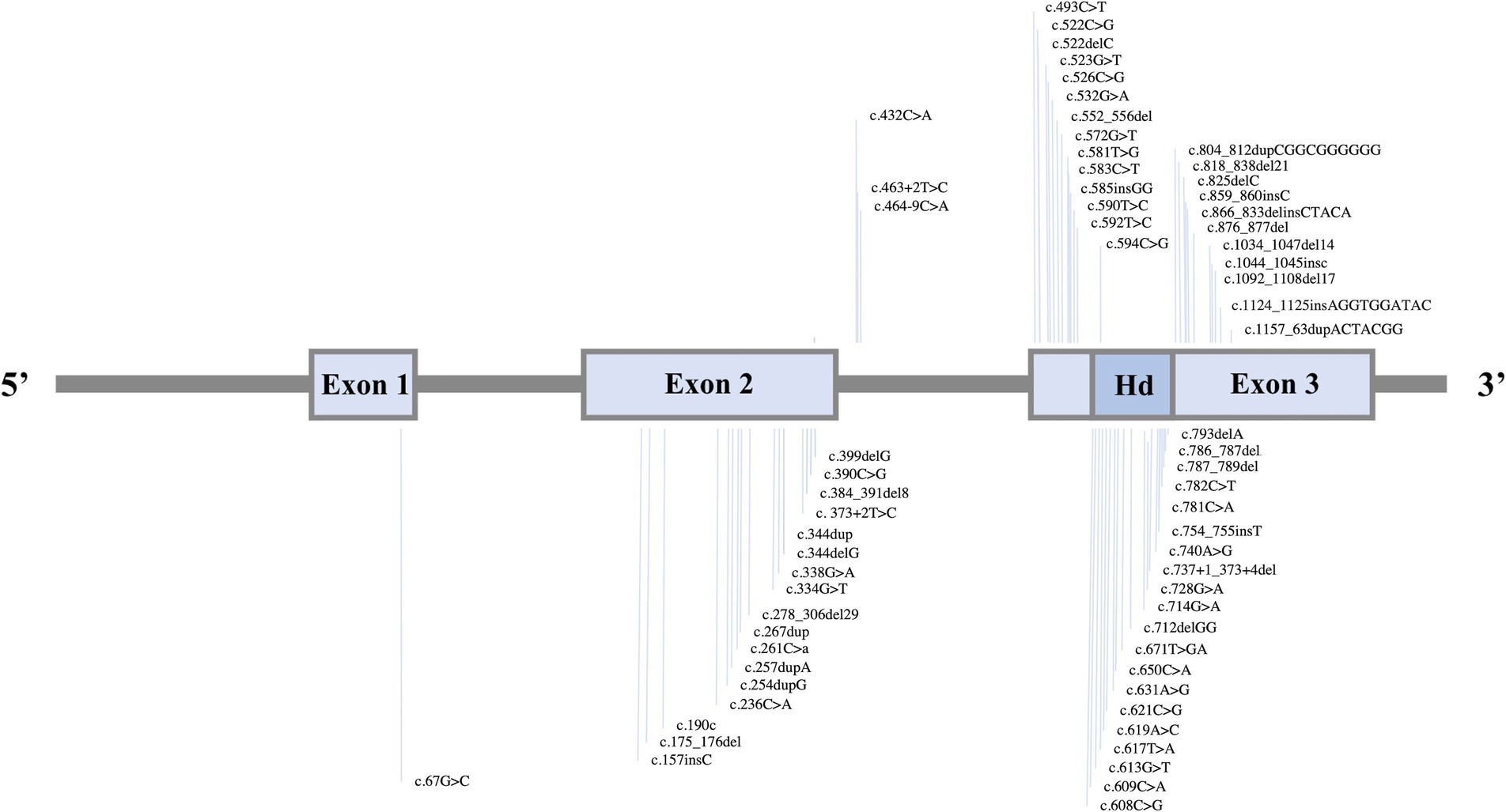
Figure 5. Distribution of 67 NKX2-1 variants with respect to the functional domains of NKX2-1 isoform 2 (RefSeq NM_003317.3). Distal and proximal promoters are indicated by arrows. Functional domains are shown in dark grey: tn (TIN domain), hd (homeodomain), and nk2 (NK2 domain).
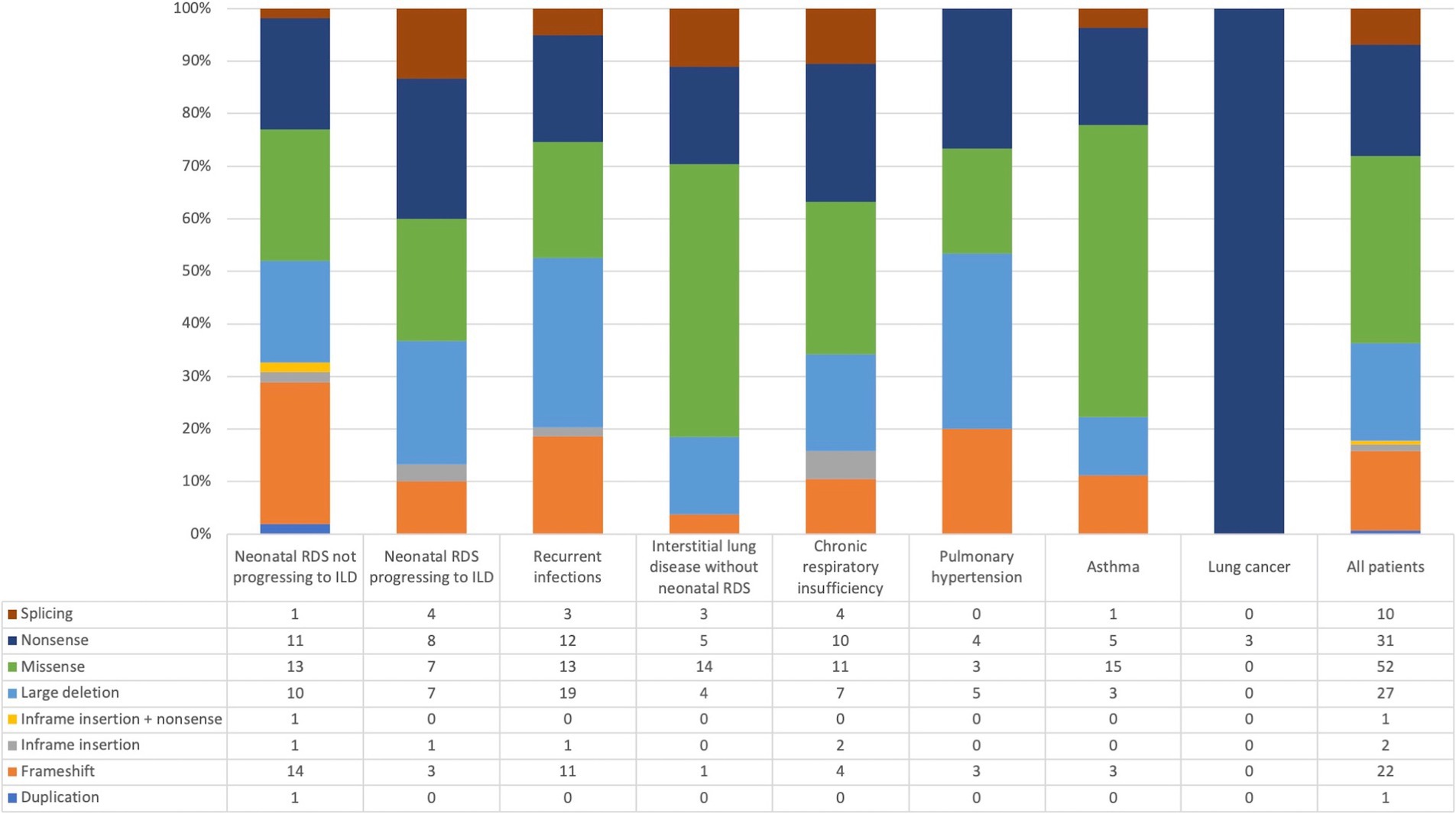
Figure 6. Distribution of patients across respiratory phenotypes and types of variants or deletions in the NKX2-1 gene.
Treatment for NKX2-1-RD
Treatment was varied, reflecting the complexity of the respiratory conditions observed. Oxygen supplementation was provided to 76% of patients (66 out of 86), with a mean duration of oxygen therapy (based on 41 patients) lasting 29.4 months. Non-invasive ventilation (NIV) was applied in 8 out of 34 cases (22, 27, 36, 37, 41, 44), while invasive ventilation was employed in 39 out of 70 patients. High-frequency oscillation (HFO) was utilized in 4 out of 48 cases (27, 33, 52, 53), inhaled nitric oxide (iNO) was administered to 5 out of 42 patients (22, 33, 44, 52, 53), and extracorporeal membrane oxygenation (ECMO) was used in 7 out of 82 patients (29, 36, 45, 53).
In terms of pharmaceutical interventions, prescriptions were distributed as follows: Long-term antibiotics were prescribed for 2 out of 33 cases, short-term antibiotics for 16 out of 32 cases, surfactant for 14 out of 47 cases, inhaled corticosteroids (ICS) for 4 out of 21 cases, systemic steroids for 27 out of 46 cases, azithromycin for 18 out of 51 cases, hydroxychloroquine (HCQ) for 10 out of 51 cases, and pirfenidone or nintedanib for 1 out of 29 cases (41).
NKX2-1-RD shows diverse long-term respiratory trajectories
Age at the last visit was available for 73 out of 148 patients (49%), with a mean of 14.8 years, a median of 6.3 years, and a range from 0.1 to 73.0 years. The duration of follow-up was provided for 52 out of 148 patients (35%), with a mean duration of 5.6 years, a median of 3.3 years, and a range from 0.1 to 24 years. The pulmonary status at the last follow-up revealed diverse outcomes among the 71 patients for whom details were available. These outcomes included 16 patients with no respiratory symptoms, 13 with chronic respiratory insufficiency, 13 who succumbed to respiratory failure, 11 with mild symptoms (sick but improved, dyspnea at rest, chronic cough, exercise intolerance), 6 with recurrent infections, 5 with pulmonary fibrosis, and 4 who passed away due to causes unrelated to respiratory insufficiency (such as lung cancer, pulmonary arterial hypertension, etc.). Five patients underwent double lung transplantation (DLTX), with an age range spanning from 7 months to 13 years (29) (Supplementary Data 6). All these patients presented with chronic respiratory insufficiency: 4 had RDS progressing to ILD, and 1 had ILD without neonatal RDS. Additionally, 3 patients experienced recurrent wheezing, asthma, or obstructive lung disease, while information on respiratory status was not available for 77 patients. The overall survival of informed cases was about 60%.
Concerning the group with recurrent infections, age at the last visit was ascertainable for 34 out of 58 patients (59%), demonstrating a mean age of 12.3 years, a median of 5.5 years, and a range spanning from 4 months to 63 years.
Figure 7A illustrates the distribution of patients across various respiratory phenotypes, stratified by vital status. Figure 7B displays the Kaplan–Meier survival curve of patients with respiratory pathology, comparing those who have undergone lung transplantation (LTX) and those who have not.
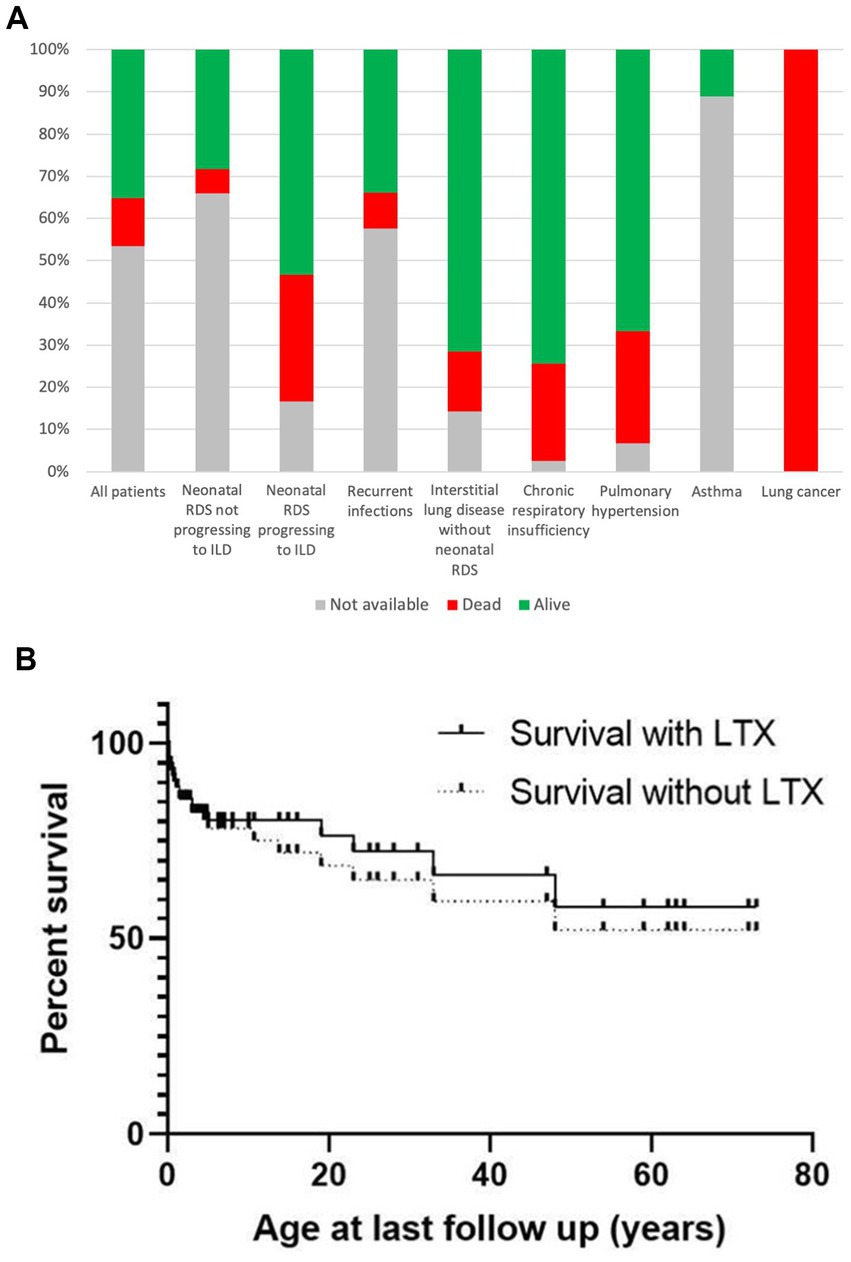
Figure 7. (A) Distribution of patients across respiratory phenotypes stratified by vital status. (B) Kaplan–Meier survival curve of NKX2-1 RD patients with respiratory manifestations, comparing those who have undergone lung transplantation (LTX) and those who have not. Note: All LTX occurred before age 20y.
Quality assessment of the included studies
According to the assessment tools used in our systematic review, 79% (n = 30) of case series and case reports had poor methodological quality, 18% (n = 7) had medium quality, and 3% (n = 1) had good quality. The scores obtained for each item, as well as the total score for each reference, are listed in Supplementary Data 7.
Discussion
This systematic review marks the first extensive examination of evidence concerning respiratory manifestations in NKX2-1-RD patients. Those with NKX2-1-RD present diverse respiratory conditions, spanning from neonatal respiratory distress to various severe lung diseases, including interstitial lung disease and lung cancer. Significantly, respiratory manifestations stand out as the leading cause of mortality in this patient group (11). An important, often overlooked respiratory problem are recurrent infections, often viral in nature, with consecutive protracted bacterial bronchitis. Such episodes may need aggressive treatment, as in a structurally hypoplastic lung, infections may lead to additional tissue damage and may trigger exacerbations of ILD. For a significant number of patients with end-stage lung disease, only lung transplantation is an option (29). This needs early attention to refer the patients in time to the appropriate transplant centers. The lack of consensus on respiratory follow-up protocols for NKX2-1 patients prior to this study underscores the necessity of such investigations.
By elucidating the complexities of NKX2-1-RD, our research highlights the criticality of evaluating thyroid function in the context of neonatal respiratory distress syndrome (RDS), specifically among females. Our research identifies a sex-specific distribution in NKX2-1-RD, with a male-to-female ratio of 1:1.32 in the overall cohort. This pattern is particularly evident in neonatal RDS cases that do not progress to interstitial lung disease (ILD), where females are more frequently affected. In contrast, among patients with neonatal RDS progressing to ILD, males are more prevalent, with a statistically significant difference in sex distribution. Given the known association between male sex and neonatal RDS, a thorough assessment of thyroid function remains critical for prompt diagnosis and intervention in all affected neonates. In addition, we support proactive measures by urging the promotion of genetic testing for mutations causing surfactant dysfunction in neonates who are fully developed and have no other plausible explanations for RDS.
Furthermore, it is crucial to emphasize the significance of conducting a thyroid profile in patients who present with chronic respiratory insufficiency, recurrent infections, interstitial lung disease, or pulmonary hypertension. This recommendation is applicable in situations where neonatal metabolic screening is normal or neonatal RDS is absent.
The identification of risk factors contributing to the progression to ILD in neonates with RDS remains inconclusive in our review. Acknowledging the significance of comprehending the factors influencing ILD development in this vulnerable population, we advocate for an elevated focus in forthcoming research endeavors to unravel these intricacies. As an initiative, an NKX2-1 patient registry has been established to enable tracking the natural history of patients, which would be beneficial in furthering our understanding of this condition.
In the clinical management of patients with NKX2-1-RD, diagnostic modalities, including computed tomography (CT), pulmonary function tests, chest radiography (CR), and lung biopsy, should be utilized with caution. These evaluations are crucial in situations where a more precise phenotypic characterization is required, as they contribute to the tailored indication of treatments and the prediction of outcomes. Nevertheless, it is advisable to exercise caution when considering the routine or preventative use of these tests, especially for those who are asymptomatic. The determination to proceed with CT, pulmonary function tests, and lung biopsy should be predicated on particular clinical indications. This entails verifying that the potential advantages, such as improved diagnostic accuracy and customized therapeutic approaches, surpass the associated risks and burdens of these diagnostic interventions.
Patients undergoing genetic analysis revealed a spectrum of NKX2-1 gene alterations, encompassing 120 pathogenic variants and 27 pathogenic deletions. Among these, nonsense mutations were identified in 31 cases. Strikingly, all instances of lung cancer were associated with nonsense variants (19, 26, 41). This specific correlation between nonsense mutations in NKX2-1 and pulmonary malignancy prompts further exploration into potential underlying biological mechanisms, warranting attention in the context of similar associations in the existing literature. This finding could influence the development of targeted screening strategies for this high-risk subset of patients.
This study presents several limitations that should be considered when interpreting its findings. Firstly, the majority of the included studies are case series and case reports, implying inherent limitations in extrapolating the results. Furthermore, the majority of the included studies (70%) have low methodological quality. Additionally, the patient sample is relatively small due to the rarity of NKX2-1-RD, potentially impacting the generalizability of the results. The lack of comprehensive data and variable reporting quality contribute to uncertainty in the overall quality of evidence. Moreover, the varying duration of follow-up and absence of control groups limit the ability to make direct comparisons and draw definitive conclusions about the effectiveness of interventions. Heterogeneity in administered treatments and the lack of detailed information on relevant outcomes also pose significant limitations. Finally, the incomplete data on long-term respiratory status for a considerable number of patients hinders a comprehensive understanding of long-term respiratory trajectories in individuals with NKX2-1-RD.
The fact that the available evidence came from case series or case reports downgrades the initial quality. Due to the lack of reported data and inadequate study design, it has not been possible to quantitatively estimate the risk of bias, inconsistency, indirectness, imprecision, and publication bias. The indirectness of the study was considered low since the available evidence answered the initial research questions. Otherwise, the imprecision of the results was high due to the small sample size and the lack of reporting of interest results.
In terms of publication bias, conducting an objective assessment was challenging due to the limited availability of data from unpublished studies. The overall quality of the evidence analyzed in this study was considered low due to the previously discussed factors.
This study exhibits several strengths that contribute to its relevance and utility. Firstly, it represents the inaugural comprehensive review of respiratory manifestations in patients with NKX2-1-RD, providing a thorough synthesis of the available evidence to date. The incorporation of diverse respiratory manifestations, ranging from neonatal respiratory distress syndrome to severe lung diseases, addresses the breadth of clinical presentation in this population, underscoring the significance of respiratory manifestations as a leading cause of mortality.
Suggestions for practical insights into NKX2-1 in the spectrum of respiratory disease
Table 2 delineates the considerations for suspecting NKX2-1 in patients with various respiratory phenotypes, highlights the distinctions in treatment compared to NKX2-1-negative patients with similar respiratory phenotypes, and provides specific key points for each pathological subgroup.
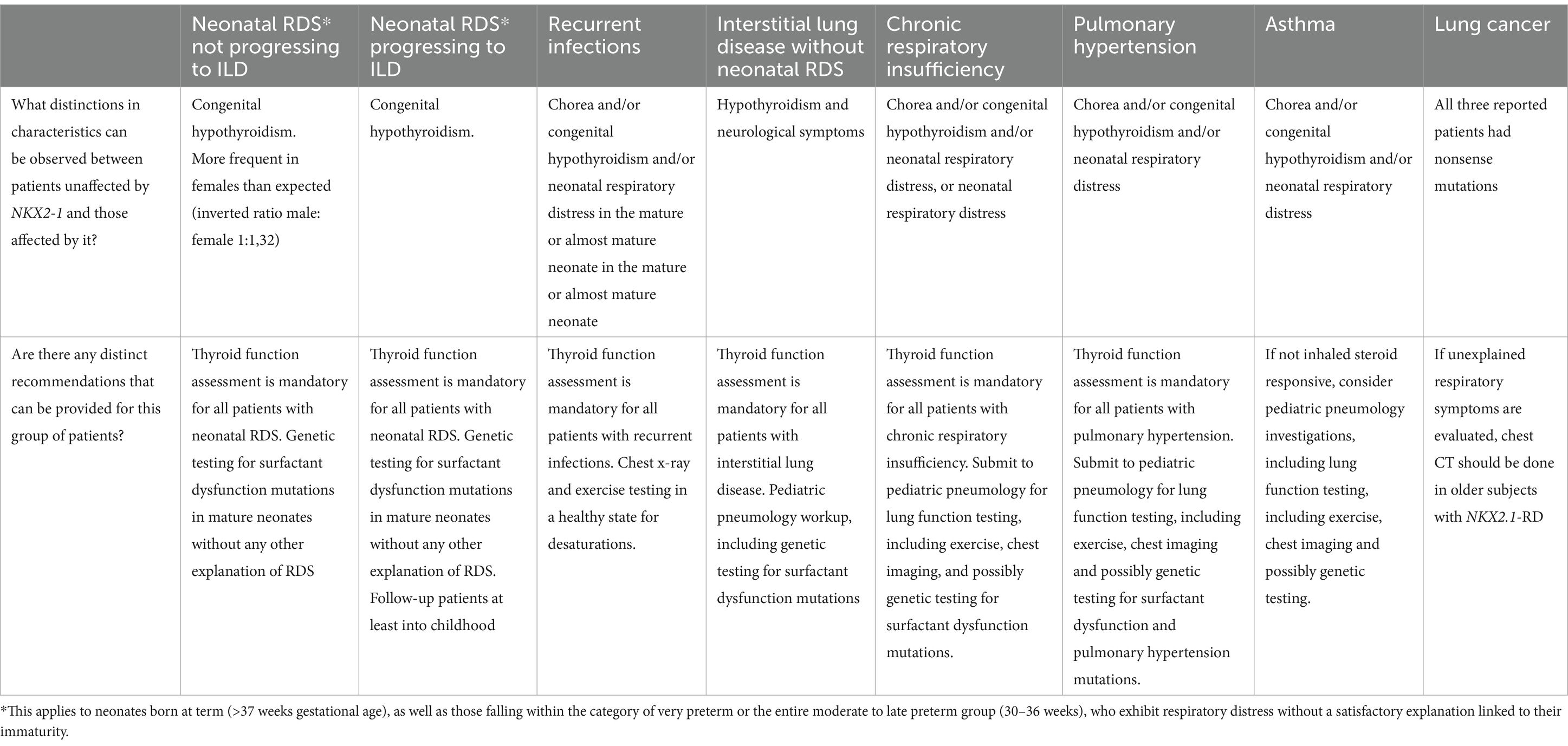
Table 2. Clinical and genetic characteristics of patients with NKX2-1-RD and associated recommendations.
Conclusion
In conclusion, this study presents the first comprehensive review of respiratory manifestations in patients with NKX2-1-RD, shedding light on the diverse clinical spectrum from neonatal respiratory distress to severe lung diseases, such as interstitial lung disease and lung cancer. The findings underscore the critical role of respiratory manifestations as a primary cause of mortality in this patient cohort. Despite certain limitations, including the predominantly low methodological quality of the reviewed studies, this work lays the foundation for future investigations and emphasizes the need for standardized respiratory follow-up protocols.
Key findings respiratory disorders in NKX2-1-RD
• Critical age of onset: The age at which respiratory symptoms manifest is diverse, with neonatal respiratory distress syndrome being a prominent initial presentation, emphasizing the importance of early detection and intervention.
• Clinical diversity: This study reveals a wide spectrum of respiratory conditions associated with NKX2-1-RD, encompassing neonatal respiratory distress to various severe lung diseases, highlighting the heterogeneous nature of this clinical entity.
• Treatment complexity: The multifaceted nature of respiratory conditions in NKX2-1-related disorders is reflected in the diverse treatment modalities employed, ranging from oxygen supplementation to advanced interventions like extracorporeal membrane oxygenation (ECMO).
• Leading cause of mortality: Respiratory manifestations emerge as the predominant cause of mortality in patients with NKX2-1-RD, underscoring the significance of understanding and managing these respiratory conditions for improved patient outcomes.
• Long-term respiratory trajectories: Long-term follow-up reveals diverse respiratory outcomes, with some patients exhibiting no respiratory symptoms while others experience chronic respiratory insufficiency, recurrent infections, or succumb to respiratory failure.
Data availability statement
All relevant data is contained within the article. The original contributions presented in the study are included in the article/Supplementary material, further inquiries can be directed to the corresponding author/s.
Author contributions
KM: Data curation, Formal analysis, Investigation, Methodology, Writing – original draft. AR-R: Data curation, Formal analysis, Methodology, Writing – review & editing. LN-F: Formal analysis, Writing – review & editing. CM-G: Methodology, Writing – review & editing. BC: Data curation, Formal analysis, Methodology, Writing – review & editing. RI-G: Methodology, Writing – review & editing. MR-L: Methodology, Writing – review & editing. RR-L: Methodology, Writing – review & editing. TW: Formal analysis, Writing – review & editing. JB-A: Methodology, Writing – review & editing. MG: Formal analysis, Methodology, Writing – review & editing. JO-E: Conceptualization, Data curation, Formal analysis, Methodology, Writing – original draft.
Funding
The author(s) declare that financial support was received for the research and/or publication of this article. This study is supported by the European Commission within the contract SANTE/2018/B3/030-SI2.813822 under which the ERNs Guidelines Program is being developed. This work is produced within the framework of the European Reference Network for Rare Neurological Diseases, Project ID 739510. MG and KM were supported by DFG Gr970/9-2.
Acknowledgments
We express our gratitude to all members of the NKX2-1-RD guideline for their support in this article.
Conflict of interest
The authors declare that the research was conducted in the absence of any commercial or financial relationships that could be construed as a potential conflict of interest.
Generative AI statement
The authors declare that no Gen AI was used in the creation of this manuscript.
Publisher’s note
All claims expressed in this article are solely those of the authors and do not necessarily represent those of their affiliated organizations, or those of the publisher, the editors and the reviewers. Any product that may be evaluated in this article, or claim that may be made by its manufacturer, is not guaranteed or endorsed by the publisher.
Supplementary material
The Supplementary material for this article can be found online at: https://www.frontiersin.org/articles/10.3389/fmed.2025.1507513/full#supplementary-material
References
1. Kuwahara, A, Lewis, AE, Coombes, C, Leung, FS, Percharde, M, and Bush, JO. Delineating the early transcriptional specification of the mammalian trachea and esophagus. eLife. (2020) 9:1–23. doi: 10.7554/eLife.55526
2. Minoo, P, Hamdan, H, Bu, D, Warburton, D, Stepanik, P, and Delemos, R. TTF-1 regulates lung epithelial morphogenesis. Dev Biol. (1995) 172:694–8. doi: 10.1006/dbio.1995.8080
3. Kimura, S, Hara, Y, Pineau, T, Fernandez-Salguero, P, Fox, CH, Ward, JM, et al. The T/ebp null mouse: thyroid-specific enhancer-binding protein is essential for the organogenesis of the thyroid, lung, ventral forebrain, and pituitary. Genes Dev. (1996) 10:60–9. doi: 10.1101/gad.10.1.60
4. Little, DR, Lynch, AM, Yan, Y, Akiyama, H, Kimura, S, and Chen, J. Differential chromatin binding of the lung lineage transcription factor NKX2-1 resolves opposing murine alveolar cell fates in vivo. Nat Commun. (2021) 12:1–18. doi: 10.1038/s41467-021-22817-6
5. Bruno, MD, Bohinski, RJ, Huelsman, KM, Whitsett, JA, and Korfhagen, TR. Lung cell-specific expression of the murine surfactant protein a (SP-A) gene is mediated by interactions between the SP-A promoter and thyroid transcription factor-1. J Biol Chem. (1995) 270:6531–6. doi: 10.1074/jbc.270.12.6531
6. Bohinski, RJ, Di Lauro, R, and Whitsett, JA. The lung-specific surfactant protein B gene promoter is a target for thyroid transcription factor 1 and hepatocyte nuclear factor 3, indicating common factors for organ-specific gene expression along the foregut Axis. Mol Cell Biol. (1994) 14:5671–81.
7. Kelly, SE, Bachurski, CJ, Burhans, MS, and Glasser, SW. Transcription of the lung-specific surfactant protein C gene is mediated by thyroid transcription factor 1. J Biol Chem. (1996) 271:6881–8. doi: 10.1074/jbc.271.12.6881
8. Snyder, EL, Watanabe, H, Magendantz, M, Hoersch, S, Chen, TA, Wang, DG, et al. Nkx2-1 represses a latent gastric differentiation program in lung adenocarcinoma. Mol Cell. (2013) 50:185–99. doi: 10.1016/j.molcel.2013.02.018
9. Liao, Y, Yang, F, Li, X, Chen, K, and Wang, J. The prognostic value of TTF-1/NKX2-1 in lung squamous cell carcinoma. Appl Immunohistochem Mol Morphol. (2023) 31:414–20. doi: 10.1097/PAI.0000000000001136
10. Yang, L, Lin, M, Ruan, WJ, Dong, LL, Chen, EG, Wu, XH, et al. Nkx2-1: a novel tumor biomarker of lung cancer. J Zhejiang Univ Sci B. (2012) 13:855–66. doi: 10.1631/jzus.B1100382
11. Delestrain, C, Aissat, A, Nattes, E, Gibertini, I, Lacroze, V, Simon, S, et al. Deciphering an isolated lung phenotype of NKX2-1 frameshift pathogenic variant. Front Pediatr. (2023) 10:1–11. doi: 10.3389/fped.2022.978598
12. Page, MJ, Moher, D, Bossuyt, PM, Boutron, I, Hoffmann, TC, Mulrow, CD, et al. PRISMA 2020 explanation and elaboration: updated guidance and exemplars for reporting systematic reviews. BMJ. (2021):372. doi: 10.1136/bmj.n160
13. Murad, MH, Sultan, S, Haffar, S, and Bazerbachi, F. Methodological quality and synthesis of case series and case reports. Evid Based Med. (2018) 23:60–3. doi: 10.1136/bmjebm-2017-110853
14. Moura-Coelho, N, Cunha, JP, Papa-Vettorazzi, R, Gris, Ó, and Güell, JL. Acute corneal allograft rejection following SARS-CoV-2 vaccination–a systematic review. Acta Ophthalmol. (2022) 101:e1–e13. doi: 10.1111/aos.15211
15. Thorwarth, A, Sarah, SH, Schrumpf, P, Müller, I, Jyrch, S, Dame, C, et al. Comprehensive genotyping and clinical characterisation reveal 27 novel NKX2-1 mutations and expand the phenotypic spectrum. J Med Genet. (2014) 51:375–87. doi: 10.1136/jmedgenet-2013-102248
16. Asmus, F, Horber, V, Pohlenz, J, Schwabe, D, Zimprich, A, Munz, M, et al. A novel TITF-1 mutation causes benign hereditary chorea with response to levodopa. Neurology. (2005) 64:1952–4. doi: 10.1212/01.WNL.0000164000.75046.CC
17. Pohlenz, J, Dumitrescu, A, Zundel, D, Martiné, U, Schönberger, W, Koo, E, et al. Partial deficiency of thyroid transcription factor 1 produces predominantly neurological defects in humans and mice. J Clin Invest. (2002) 109:469–73. doi: 10.1172/JCI0214192
18. Ferrara, AM, De Michele, G, Salvatore, E, Di Maio, L, Zampella, E, Capuano, S, et al. A novel NKX2.1 mutation in a family with hypothyroidism and benign hereditary chorea. Thyroid. (2008) 18:1005–9. doi: 10.1089/thy.2008.0085
19. Willemsen, MAAP, Breedveld, GJ, Wouda, S, Otten, BJ, Yntema, JL, Lammens, M, et al. Brain-thyroid-lung syndrome: a patient with a severe multi-system disorder due to a de novo mutation in the thyroid transcription factor 1 gene. Eur J Pediatr. (2005) 164:28–30. doi: 10.1007/s00431-004-1559-x
20. Peall, KJ, Lumsden, D, Kneen, R, Madhu, R, Peake, D, Gibbon, F, et al. Benign hereditary chorea related to NKX2.1: expansion of the genotypic and phenotypic spectrum. Dev Med Child Neurol. (2014) 56:642–8. doi: 10.1111/dmcn.12323
21. Glik, A, Vuillaume, I, Devos, D, and Inzelberg, R. Psychosis, short stature in benign hereditary chorea: a novel thyroid transcription factor-1 mutation. Mov Disord. (2008) 23:1744–7. doi: 10.1002/mds.22215
22. Iwatani, N, Mabe, H, Devriendt, K, Kodama, M, and Miike, T. Deletion of NKX2.1 gene encoding thyroid transcription factor-1 in two siblings with hypothyroidism and respiratory failure. J Pediatr. (2000) 137:272–6. doi: 10.1067/mpd.2000.107111
23. Devos, D, Vuillaume, I, de Becdelievre, A, de Martinville, B, Dhaenens, CM, Cuvellier, JC, et al. New syndromic form of benign hereditary chorea is associated with a deletion of TITF-1 and PAX-9 contigous genes. Mov Disord. (2006) 21:2237–40. doi: 10.1002/mds.21135
24. Krude, H, Schütz, B, Biebermann, H, von Moers, A, Schnabel, D, Neitzel, H, et al. Choreoathetosis, hypothyroidism, and pulmonary alterations due to human NKX2-1 haploinsufficiency. J Clin Invest. (2002) 109:475–80. doi: 10.1172/JCI0214341
25. Barnett, CP, Mencel, JJ, Gecz, J, Waters, W, Kirwin, SM, Vinette, KMB, et al. Choreoathetosis, congenital hypothyroidism and neonatal respiratory distress syndrome with intact NKX2-1. Am J Med Genet A. (2012) 158A:3168–73. doi: 10.1002/ajmg.a.35456
26. Gras, D, Jonard, L, Roze, E, Chantot-Bastaraud, S, Koht, J, Motte, J, et al. Benign hereditary chorea: phenotype, prognosis, therapeutic outcome and long term follow-up in a large series with new mutations in the TITF1/NKX2-1 gene. J Neurol Neurosurg Psychiatry. (2012) 83:956–62. doi: 10.1136/jnnp-2012-302505
27. Gu, R, Ye, G, Zhou, Y, and Jiang, Z. Combined mutations of NKX2-1 and surfactant protein C genes for refractory low oxyhemoglobin saturation and interstitial pneumonia: a case report. Med (United States). (2020) 99
28. Guillot, L, Carré, A, Szinnai, G, Castanet, M, Tron, E, Jaubert, F, et al. NKX2-1mutations leading to surfactant protein promoter dysregulation cause interstitial lung disease in “brain-lung-thyroid syndrome”. Hum Mutat. (2010) 31:E1146–62. doi: 10.1002/humu.21183
29. Hamvas, A, Deterding, RR, Wert, SE, White, FV, Dishop, MK, Alfano, DN, et al. Heterogeneous pulmonary phenotypes associated with mutations in the thyroid transcription factor gene NKX2-1. Chest. (2013) 144:794–804. doi: 10.1378/chest.12-2502
30. Hanes, I, Mestre, T, and Doja, A. An 8-year-old boy with ataxia and abnormal movements. Paediatr Child Heal. (2019) 24:297–8. doi: 10.1093/pch/pxy178
31. Hu, X, Liu, J, Guo, R, Guo, J, Zhao, Z, Li, W, et al. A novel 14q13.1-21.1 deletion identified by CNV-Seq in a patient with brain-lung-thyroid syndrome, tooth agenesis and immunodeficiency. Mol Cytogenet. (2019) 12:4–9. doi: 10.1186/s13039-019-0463-z
32. Villamil-Osorio, M, Yunis, LK, Quintero, L, Restrepo-Gualteros, S, Yunis, JJ, Jaramillo, L, et al. Brain-lung-thyroid syndrome in a newborn with deletion 14q12-q21.1. Andes Pediatr. (2021) 92:930–6. doi: 10.32641/andespediatr.v92i6.3287
33. Kleinlein, B, Griese, M, Liebisch, G, Krude, H, Lohse, P, Aslanidis, C, et al. Fatal neonatal respiratory failure in an infant with congenital hypothyroidism due to haploinsufficiency of the NKX2-1 gene: alteration of pulmonary surfactant homeostasis. Arch Dis Child Fetal Neonatal Ed. (2011) 96:F453–6. doi: 10.1136/adc.2009.180448
34. Koht, J, Løstegaard, SO, Wedding, I, Vidailhet, M, Louha, M, and Tallaksen, CME. Benign hereditary chorea, not only chorea: a family case presentation. Cereb Ataxias. (2016) 3:1–7. doi: 10.1186/s40673-016-0041-7
35. Carré, A, Szinnai, G, Castanet, M, Sura-Trueba, S, Tron, E, Broutin-L’Hermite, I, et al. Five new TTF1/NKX2.1 mutations in brain-lung-thyroid syndrome: rescue by PAX8 synergism in one case. Hum Mol Genet. (2009) 18:2266–76. doi: 10.1093/hmg/ddp162
36. LeMoine, BD, Browne, LP, Liptzin, DR, Deterding, RR, Galambos, C, and Weinman, JP. High-resolution computed tomography findings of thyroid transcription factor 1 deficiency (NKX2–1 mutations). Pediatr Radiol. (2019) 49:869–75. doi: 10.1007/s00247-019-04388-3
37. Lynn, MM, Simon, D, and Kasi, AS. Hypoxaemia and interstitial lung disease in an infant with hypothyroidism and hypotonia. BMJ Case Rep. (2020) 13. doi: 10.1136/bcr-2020-238466
38. Maquet, E, Costagliola, S, Parma, J, Christophe-Hobertus, C, Oligny, LL, Fournet, JC, et al. Lethal respiratory failure and mild primary hypothyroidism in a term girl with a de novo heterozygous mutation in the TITF1/NKX2.1 gene. J Clin Endocrinol Metab. (2009) 94:197–203. doi: 10.1210/jc.2008-1402
39. Marić, N, and Ljuboja, O. Pulmonary hemorrhage in a patient with brain-lung-thyroid syndrome caused by a p.T86fs variant in the nkx2-1 gene. Cent Eur J Paediatr. (2020) 16:155–60. doi: 10.5457/p2005-114.271
40. Mirza, A, Martinez, M, and Kilaikode, S. Unusual cause of respiratory distress in a term neonate. Ochsner J. (2022) 22:196–8. doi: 10.31486/toj.21.0101
41. Nattes, E, Lejeune, S, Carsin, A, Borie, R, Gibertini, I, Balinotti, J, et al. Heterogeneity of lung disease associated with NK2 homeobox 1 mutations. Respir Med. (2017) 129:16–23. doi: 10.1016/j.rmed.2017.05.014
42. Nevel, RJ, Garnett, ET, Worrell, JA, Morton, RL, Nogee, LM, Blackwell, TS, et al. Persistent lung disease in adults with NKX2.1 mutation and familial neuroendocrine cell hyperplasia of infancy. Ann Am Thorac Soc. (2016) 13:1299–304. doi: 10.1513/AnnalsATS.201603-155BC
43. Parnes, M, Bashir, H, and Jankovic, J. Is benign hereditary chorea really benign? Brain-lung-thyroid syndrome caused by NKX2-1 mutations. Mov Disord Clin Pract. (2019) 6:34–9. doi: 10.1002/mdc3.12690
44. Prasad, R, Nicholas, AK, Schoenmakers, N, and Barton, J. Haploinsufficiency of NKX2-1 in brain-lung-thyroid syndrome with additional multiple pituitary dysfunction. Horm Res Paediatr. (2020) 92:340–4. doi: 10.1159/000503683
45. Safi, KH, Bernat, JA, Keegan, CE, Ahmad, A, Hershenson, MB, and Arteta, M. Interstitial lung disease of infancy caused by a new NKX2-1 mutation. Clin Case Reports. (2017) 5:739–43. doi: 10.1002/ccr3.901
46. Salerno, T, Peca, D, Menchini, L, Schiavino, A, Petreschi, F, Occasi, F, et al. Respiratory insufficiency in a newborn with congenital hypothyroidism due to a new mutation of TTF-1/NKX2.1 gene. Pediatr Pulmonol. (2014) 49:42–4.
47. Salvado Figueras, M, Boronat Guerrero, S, Hernández Vara, J, and Álvarez, SJ. Corea por mutación deTITF1/NKX2-1: descripción fenotípica y respuesta terapéutica en una familia. Rev Neurol. (2013) 56:515. doi: 10.33588/rn.5610.2013029
48. Sutton, RM, Bittar, HT, Sullivan, DI, Silva, AG, Bahudhanapati, H, Parikh, AH, et al. Rare surfactant-related variants in familial and sporadic pulmonary fibrosis. Hum Mutat. (2022) 43:2091–101. doi: 10.1002/humu.24476
49. Jovien, S, Borie, R, Doummar, D, Clement, A, and Nathan, N. Respiratory distress, congenital hypothyroidism and hypotonia in a newborn. Respiration. (2016) 92:188–91. doi: 10.1159/000449136
50. Doyle, DA, Gonzalez, I, Thomas, B, and Scavina, M. Autosomal dominant transmission of congenital hypothyroidism, neonatal respiratory distress, and ataxia caused by a mutation of NKX2-1. J Pediatr. (2004) 145:190–3. doi: 10.1016/j.jpeds.2004.04.011
51. Ferrara, JM, Adam, OR, Kirwin, SM, Houghton, DJ, Shepherd, C, Vinette, KMB, et al. Brain-lung-thyroid disease: clinical features of a kindred with a novel thyroid transcription factor 1 mutation. J Child Neurol. (2012) 27:68–73. doi: 10.1177/0883073811413584
52. Galambos, C, Levy, H, Cannon, CL, Vargas, SO, Reid, LM, Cleveland, R, et al. Pulmonary pathology in thyroid transcription factor-1 deficiency syndrome. Am J Respir Crit Care Med. (2010) 182:549–54. doi: 10.1164/rccm.201002-0167CR
53. Gillett, ES, Deutsch, GH, Bamshad, MJ, Mcadams, RM, and Mann, PC. Novel NKX2.1 mutation associated with hypothyroidism and lethal respiratory failure in a full-term neonate. J Perinatol. (2013) 33:157–60. doi: 10.1038/jp.2012.50
54. Borie, R, Funalot, B, Epaud, R, Delestrain, C, Cazes, A, Gounant, V, et al. NKX2.1 (TTF1) germline mutation associated with pulmonary fibrosis and lung cancer. ERJ Open Res. (2021) 7:00356–2021. doi: 10.1183/23120541.00356-2021
Keywords: NKX2-1, benign hereditary chorea, interstitial lung disease, neonatal respiratory distress, asthma, recurrent respiratory infection, systematic review, brain-thyroid-lung syndrome
Citation: Michel K, Ruiz-Ramos A, Nou-Fontanet L, Martín-Gomez C, Carmona Hidalgo B, Isabel-Gomez R, Rosario-Lozano MP, Rodriguez-Lopez R, Wagner TOF, Blasco-Amaro JA, Griese M and Ortigoza-Escobar JD (2025) Respiratory and other organ manifestations in NKX2-1-related disorders: a systematic review. Front. Med. 12:1507513. doi: 10.3389/fmed.2025.1507513
Edited by:
Ron Rubenstein, Washington University in St. Louis, United StatesReviewed by:
Jo Harrison, Royal Children’s Hospital, AustraliaAlicia Casey, Boston Children’s Hospital and Harvard Medical School, United States
Mary Elizabeth Moss, Boston Children’s Hospital, United States, in collaboration with reviewer AC
Copyright © 2025 Michel, Ruiz-Ramos, Nou-Fontanet, Martín-Gomez, Carmona Hidalgo, Isabel-Gomez, Rosario-Lozano, Rodriguez-Lopez, Wagner, Blasco-Amaro, Griese and Ortigoza-Escobar. This is an open-access article distributed under the terms of the Creative Commons Attribution License (CC BY). The use, distribution or reproduction in other forums is permitted, provided the original author(s) and the copyright owner(s) are credited and that the original publication in this journal is cited, in accordance with accepted academic practice. No use, distribution or reproduction is permitted which does not comply with these terms.
*Correspondence: Juan Darío Ortigoza-Escobar, anVhbmRhcmlvLm9ydGlnb3phQHNqZC5lcw==; Matthias Griese, bWF0dGhpYXMuZ3JpZXNlQG1lZC51bmktbXVlbmNoZW4uZGU=
†These authors have contributed equally to this work
‡These authors share senior authorship
 Katarzyna Michel1,2†
Katarzyna Michel1,2† Alba Ruiz-Ramos
Alba Ruiz-Ramos Carmen Martín-Gomez
Carmen Martín-Gomez Beatriz Carmona Hidalgo
Beatriz Carmona Hidalgo Rebeca Isabel-Gomez
Rebeca Isabel-Gomez María Piedad Rosario-Lozano
María Piedad Rosario-Lozano Rocio Rodriguez-Lopez
Rocio Rodriguez-Lopez Juan Antonio Blasco-Amaro
Juan Antonio Blasco-Amaro Matthias Griese
Matthias Griese Juan Darío Ortigoza-Escobar
Juan Darío Ortigoza-Escobar